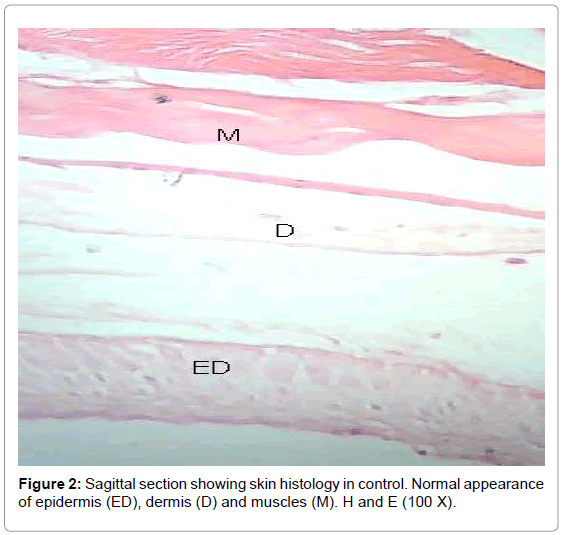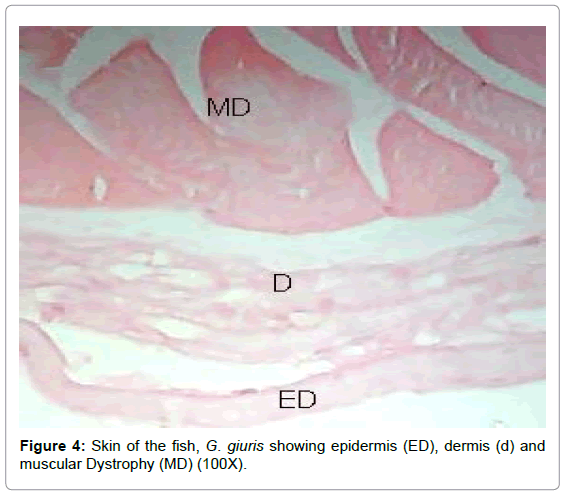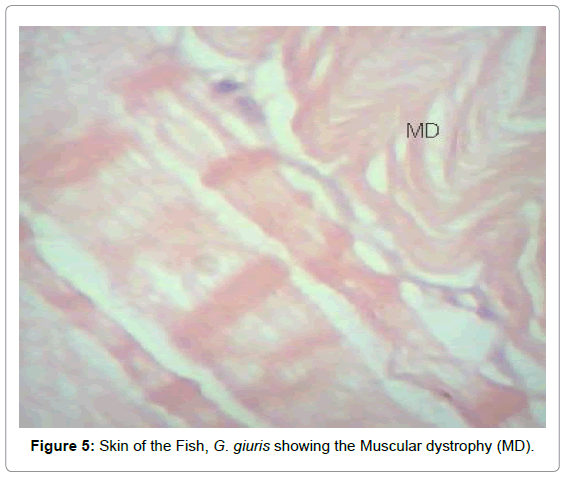Research Article Open Access
Impact of Biopesticde Neem Oil for Beneficial to Fisheries Resources Studies on Skin with Neem Oil Exposure to Fresh Water Fish G. Giuris
Ramachandramohan M* and Mamatha P
Lake Water quality research Laboratory, Department of Zoology, Bangalore University, Bangalore- 560 056, India
- *Corresponding Author:
- Ramachandramohan M
Lake Water quality research
Laboratory Department of Zoology
Bangalore University
Bangalore- 560 056, India
E-mail: mohanramachandr@gmail.com
Received Date: November 03, 2014 Accepted Date: April 28, 2015 Published Date: May 05, 2015
Citation: Ramachandramohan M, Mamatha P (2015) Impact of Biopesticde Neem Oil for Beneficial to Fisheries Resources – Studies on Skin with Neem Oil Exposure to Fresh Water Fish G. Giuris. J Fisheries Livest Prod 3:132. doi:10.4172/2332-2608.1000132
Copyright: © 2015 Ramachandramohan M, et al. This is an open-access article distributed under the terms of the Creative Commons Attribution License, which permits unrestricted use, distribution, and reproduction in any medium, provided the original author and source are credited.
Visit for more related articles at Journal of Fisheries & Livestock Production
Abstract
This study provides a comprehensive description of skin histopathology of fresh water fish, Glossogobius giuris, after exposing them to 96 hrs (0.25 ppm, 0.5 ppm and 1.0 ppm) of Neem oil and its effects were determined. Mature fish weighing 12 ± 2 g were selected. Experiments were performed and all changes in the specimens were determined at each concentration. The results indicated that the intracellular spaces, the separation of individual cells by muscular dystrophy, necrotic change, vacuolization and degeneration of cells, hyperplasia and hypertrophy of epidermis, results of present study revealed that the acute neem oil toxicity affects mildly and cause less effects on the structure of skin and it may not as impact as organophosporus pesticide on Gobiid fish population in the habitat i.e. Cauvery delta region of Karnataka, India.
Keywords
Skin, G. giuris; Azadirachtin; Cauvery river
Introduction
Glossogobius giuris [1] (Figure 1), Common names Bar eyed goby, Flat head goby, Fresh water goby, were found in Indian fresh water bodies. The importance of studying this fish is to evaluate its very existence and survival in Bangalore region [2] and to discuss the implications for its exit in this particular area.
Extensive work has been carried out on skin normal physiological functions like respiratory, excretory and osmoregulatory. It is a selfactive secretary organ which provides number of useful products. Mucous glands whose secretion plays a major role in protection against stress factors, imposed by changes in the nature and chemical composition of surrounding water [3]. It keeps the body surface moist, acts as antibacterial and antifungal agent [4]. Also, the skin houses the alerted content of club cells which initiates alarm reaction [5]. The skin contains melanocytes which provide fish with its specific coloration [6]. Glossogobius giuris fish differs from that of higher vertebrates in that the epidermis is composed of non- keratinized living cells. Epidermal integrity is vital to fish in maintaining osmotic balance and excluding micro-organisms. The epidermal healing response in this fish is extraordinarily low, even at low temperatures [7,8]. Whereas work on neem toxicity on bottom dwelling fish, G. giuris is lacking. Therefore in this context the need for such a work in indeed need of an hour.
Dorsal spines (total): 7; Dorsal soft rays (total): 8-9; Anal spines: 1; Anal soft rays: 8-9. Head flattened, lower jaw projecting; body pale without longitudinal lines. Dorsal fins with small spots forming longitudinal stripes. Pelvic fins jointed but attached to the body only from their anterior part. The body is brownish yellow with 5 to 6 dark and rounded spots on its sides. Some specimens living on dark substrates can be very dark also. Some living on very light substrates show an ivory coloration. Dorsal fins are light with brownish spots. Pelvic fins are grey. Pectorals and caudal are grey and often hyaline.
The Azadirachtin pesticides are used to prevent the pest and thereby increase the agricultural production. They are carried away by rains and floods to water bodies and alter the properties of water [9]. The organophosphorus Pesticides are potentially more toxic to fish and other aquatic organism owing to the excessive use of synthetic pesticides, the environment and water resources are being polluted, thus endangering aquatic life directly and human life indirectly.
To overcome the hazardous effects of organic chemicals natural pesticides of plant origin are used. Plants are virtually inexhaustible sources of structurally diverse and biologically active substances [10]. Neem (Azadirachta indica Azadirachta juss) is also a traditional and highly esteemed medicinal tree for the people of Indian Subcontinent [11], Azadirachtin (a tetratriterpenoid) is one of the major components of neem [12,13] which have pesticide properties [14].
The neem is used in organic manure as with insecticide properties. It is a potential source of organic manure and is rich in many plant nutrients namely nitrogen (2-3%), phosphorus (1%) and potassium (1,4%). Recently neem based pesticides are popularized due to their effectiveness, cheaper price and comparatively safe for users, which is used widely in several states of India. The present study was undertaken to understand skin alteration of edible fish, Glossogobius giuris in the Mandya district of Cauvery belt.
Materials and Methods
The fishes, Glossogobius giuris (10-12 ± 2 g wt and 10-12 ± 3 cm in length) were collected from the Cauvery delta region of Karnataka, India. Then fish were acclimatized prior to subject them to experiments for 15 days in the laboratory conditions in glass aquaria. During the experiment fish were fed with tube-fix. Acclimatized fish were divided into 4 groups of 10 each as first group and served as the control, while remaining three groups were exposed for sub lethal concentrations of 0.25, 0.5 and 1 ppm of neem oil for 24, 48, 72 and 96 hrs respectively. Fish were sacrificed periodically, at the end of 24, 48, 72 and 96 hrs, and their skin was excised, fixed in Bouin’s fluid and were processed with standard histological techniques. Tissues were embedded in paraffin wax of 56 -58°C and serial section of 4-6 micrometer thickness were cut, stained in Haematoxylin and counter stained with Eosin. The sections were examined under light microscopy and microphotographs are recorded.
Results & Discussion
The Glossogobius giuris, Gobiid fish skin comprising the cuticle, epidermis, basement membrane, dermis (comprising stratum laxum (spongiosum) stratum compactum), and hypodermis (sub-cutis). The external layer, the cuticle is a mucopolysaccharide layer approximately 1micrometer thick. It is secreted by epithelial surface cells.
The epidermis is composed of a non-keratinized stratified squamous epithelium of variable thickness (4 to 20 cells thick). The outermost epidermal cells (Malpighian cell layer) retain the capacity to divide. Other cells present in the epidermis are goblet cells, large eosinophilic club cells or alarm cells (present in most species of fish), eosinophilic granular cells (unknown function), leukocytes and macrophages, Pigment cells and sensory structures are the characteristic features of Teleost skin. The epidermis is formed of thickened stratified squamous epithelium having a well definite basal layer of columnar cells, stratum germinativum, which is situated on a thin basement membrane. On the top of stratum germinativum lies several layers of fusiform cells covered by a superficial squamous cells.
The mucous cells are distributed in the middle layers of the epidermis and have its base on the basement membrane. These cells directly open onto the surface. Mucous cells responsible for secreting glycoprotein (mucus) forming a slimy protective coat. The functions include predator evasion and isolation of superficial epithelial cells from bacteria. Immunoglobulins, also present in mucus, provide additional protection against infection. Dermis consists of two distinct layers – the outer stratum laxum (spongiosum) and the inner stratum compactum. The stratum spogiosum is a loose network of collagen and reticular fibres continuous with the epidermal basement membrane. It contains the pigment cells (Chromatophores), mast cells and also the scales. Scales are calcified plates originating in the dermis and covered by the epidermis. Cycloid scales of teleost fish have a smooth outer surface and are laid down in concentric a ring that makes them useful in determining the age of some fish. Scales also represent a source of calcium for fish; some fish will utilize the calcium in the scales in preference to the calcium in their skeleton during times of starvation or pre-spawning activity. Sub cutis is a loose adipose tissue, which is more vascular than the overlying stratum compactum of the dermis.
Histology of skin of control fish shows the normal structure of skin of G. giuris and is made up of three layers, the epidermis, dermis and sub-cutis (Figure 2). The cellular constitutent of the epidermis includes epithelial cells, club cells and goblet cells. During the treatment with neem oil of 1.0 ppm for 96 hrs affected the surface epithelium and caused marked histopathological changes including disintegration and disorganization (Figure 3). Degeneration of all layers of skin and absence of cellular arrangement were noted. Atrophy of all layers of skin was also evident in the fish, G. giuris. These findings are in line with the findings of Rajan and Banerji [15] who reported degeneration of the cells of skin and disturbance of normal histology of the epidermis of Grass carp.
Hypertrophy of the epithelial cells, obstruction of the goblet cells and cellular proliferation were evident in the fish, G. giuris after treatment with 0.5 ppm for 72 hrs (Figure 4). Similar results are reported by Oliveira and Torres in the fish Grass carp. Further Vacuolization and muscular atrophy were observed. These findings are in line with the findings of Rajan and Banerji [15].
Skin of the Fish, G. giuris showing the Muscular dystrophy (MD) after exposure to 0.5 ppm for 96 hrs (Figure 5).
Mucous glands whose secretion plays a major role in protection against stress factors, imposed by changes in the nature and chemical composition of surrounding water. Glossogobius giuris fish differs from that of higher vertebrates in that the epidermis is composed of non- keratinized living cells. Epidermal integrity is vital to fish in maintaining osmotic balance and excluding micro-organisms. The epidermal healing response in this fish is extraordinarily low, even at low temperatures [7].
Conclusion
The consequences of abnormal usage of chemical pesticides for more crop yield, the inland freshwater fisheries resources of India are suffering similar consequences from the conflict between economic growth and biodiversity conservation. A serious habitat loss, impact of pesticide pollution, lack of water management and Urban Development variation of climate change, natural habitat change and patterns of aquaculture are main cause. Therefore the usage of bio pesticide like Neem oil are beneficial to fisheries resources which will continue to be threatened, at an increasing rate, as long as the Indian economy continues to grow, ensuring the competitive exclusion of fishes and other aquatic species.
References
- Hamilton F (1822)An account of the fishes found in the River Ganges and its Branches. Archibald constable and company, Edinburg.
- Mohan (2000)Malathion induced changes in the ovary of fresh water fish, Glossogobiusgiuris (Ham). Poll Res. 1: 15-36.
- Zuchelkowski EM, Pinkstaff CA, Hinton DE(1985)Mucosubstancehistochemistry in control and acid- stress epidermis of Brown bull head (Ictalurusnebulosus L.). Anatomical Record J 212: 327-335.
- Gona O (1979) Mucous glycoproteins of teleostean fish a comparative histochemical study. Histochemistry 11: 709-718.
- Pfeilfer WD, Sasse,Amold M (1971) Die Schreckstoffzellenvonphoximus and Moruluschrysophekadion (Cyprinidae, Ostariophysi, Pisces) zellforsch, 118 : 203- 213.
- Lagler K.F, Bardach JE, Miller RR, Passino DR (1977)B Ichthyology. New York, London, Sydney.
- Robert RJ, Bullock AM (1980)Histochemistry and kinetics of the epidermis of someBritish Teleost Fishes. National Marine Biological Library 9: 13-22.
- Mohan (1991) Experimental studies on the Hypothalamohypophyseal -ovarian system of fresh water Gobiid fish, Glossogobiusgiuris. Bangalore.
- Ansari BA, Ahmad MK (2010) Toxicity of pyrethroid Lambda- Cyhalothrin and Neemgold to the embryo of ZebrafishDaniorerio ( Cyprinidae ). J. Appl. Biosci. 36:97-100.
- Istvan U (2000)Semi natural products and related substances as alleged botanical pesticides. PestManag. Sci. 56: 703-705.
- Biswas, Chattopadhyay K.I, Banerjee RK,Bandyopadhyay U (2002) Biological activities and medicinal properties of neem (Azadirachtaindica ).Curr.Sci. 82: 1336-1345.
- Broughton HB, Ley SV,Slawin AMZ, Williams JD,MorganED(1986) X-ray crystallographic structure determination of detigloyldihydroazadirachtin and reassignment of the structure of the limionoid insect antifeedentazadirachtin. Journal of Chem. Soc. Chem. commun.
- Saxena RC (1990) Insecticides fromneem. In:Arnason, J. T. B. J. R. philogene and P. Morand, (Eds.), Insecticide of plant origin. ACS Symp. Ser.387, American chem. Soci. Washington D. C.
- Anjaneyulu GVSR, Mishra K.D (1999) Acute toxicity of neemax (Neem seed powder) to a fresh water fish, Puntiusticto Ham. Poll. Res. 18: 391-394.
- Rajan MT, Banerjee TK (1991) Histopathological changes induced by acute toxicity of mercuric chloride on the epidermis of a freshwater catfish - Heteropneustesfossilis (Bloch). Ecotoxicol. Environ. Safety 22: 139-152.
Relevant Topics
- Acoustic Survey
- Animal Husbandry
- Aquaculture Developement
- Bioacoustics
- Biological Diversity
- Dropline
- Fisheries
- Fisheries Management
- Fishing Vessel
- Gillnet
- Jigging
- Livestock Nutrition
- Livestock Production
- Marine
- Marine Fish
- Maritime Policy
- Pelagic Fish
- Poultry
- Sustainable fishery
- Sustainable Fishing
- Trawling
Recommended Journals
Article Tools
Article Usage
- Total views: 16817
- [From(publication date):
September-2015 - Jan 02, 2025] - Breakdown by view type
- HTML page views : 12341
- PDF downloads : 4476





